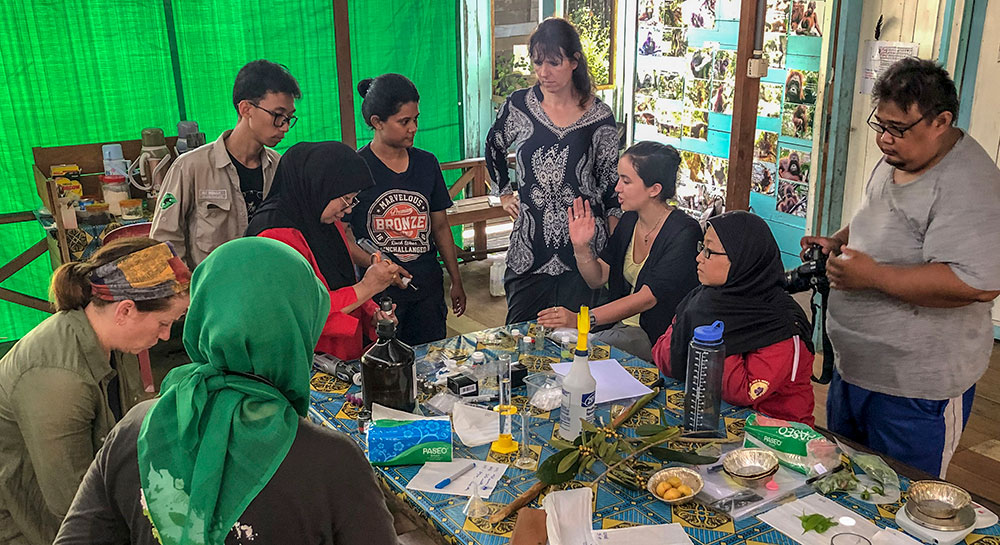 Zoom in
Zoom in
A still quiet fell upon us the moment we saw Mindy in a tree. Gripping a branch effortlessly and snacking on some fruit, her bright colored hair flowing as she checked on her toddler playing in a tree beside her. We had ventured deep into the Kalimantan rainforest to greet Mindy and her child, the both of them peacefully going about their usual day, disinterested in the humans below gasping with excitement and awe.
I only ever saw orangutans in books I read or online, in this instance it was by treading through the thick rainforests of Indonesia. It’s a very misleading thing to rely on google images. The diversity of orangutan depictions found there were limited either to giant powerful male orangutans or adorable big eyed, wispy haired infants. Mindy resembled neither of these. To watch her interact with her daughter was parallel to any mother-child relationship, exasperated when the baby climbed or pulled on her hair, and content when she was playing happily.
Dr. Raskin and I have been invited to the Tuanan Research Center (Central Kalimantan, ID) by its director, Dr. Erin Vogel of Rutgers University, to help shed light on orangutan diet. It already being known what plants are their food of choice, but not if that choice is conscious of the medicinal potential tucked within the fruits flesh. Our mission was to answer the question if Mindy, and orangutan kind, are treating themselves with specific plants when infected or ill. Might Mindy the orangutan, know more about medical properties of Indonesian flora than our best human scientists?
Waiting for us at the camp was a long and carefully planned day that took almost a year to organize. The first day of a GIBEX workshop is always very busy as all plant material must be collected and processed in a short span of time. We had a handful of experts in our group that knew how to accurately identify plants, and which plants were frequently eaten by orangutans, they collected and delivered our plant samples. Once all material was collected, I proceeded to teach our class of 12 Indonesian scientists Rapid Metabolome Extraction and Storage (RAMES) technology [1]. Beginning with weighing 2 grams of plant tissue on our battery operated balances, I continued on to show them how to load the extraction chamber and attach the Dremel® rotary tool. It’s always an exciting and happy experience to watch everyone’s face light up when showing them the puree created after only a minute of operating our extraction tool. Everyone wanted to try to make their own, eager to see the remainder of the process. The puree then got filtered and our liquid plant extract was loaded onto 10 mm glass fiber discs. By lunch time we had made 300 of such discs, impregnated by various plant leaves, roots, flowers, and even a few fungi.
After lunch we began our first steps toward unveiling the possible healing properties of these plants. I had brought four assays, all made field deployable to accommodate for an absence of a wet laboratory in the rainy forest. Two antifungal (one targeting Fusarium spp. and another targeting Saccharomyces cerevisiae), an antibacterial (using oral microbiome), and an anthelmintic (free living nematode Panagrellus redivivus) assay were taught. Workshop participants learned how to add Fusarium from their growing medium into liquid media for testing, prepare agar plates for long term fungal growth, plate yeast and other microbiological techniques. Once completed, everyone involved in the workshop, from our registered participants all the way to the forest guides and film crew, clamored over the assays to enthusiastically confirm our findings. Results showed a large percentage of plants carry antibacterial and antifungal properties, majority held anti-yeast (S. cerevisiae) potential.
The researchers of Tuanan will continue on to watch the orangutans, recording and testing the plants eaten. Only time will tell if there is a correlation between particular orangutan infections and the fruits they choose to eat, but on that last day of workshop the gap between foreign plants and potential antimicrobials got just a little bit smaller.
References
- Skubel SA, Dushenkov V, Graf BL, Niu Q, Poulev A, et al. (2018) Rapid, field-deployable method for collecting and preserving plant metabolome for biochemical and functional characterization. PLOS ONE 13(9): e0203569




